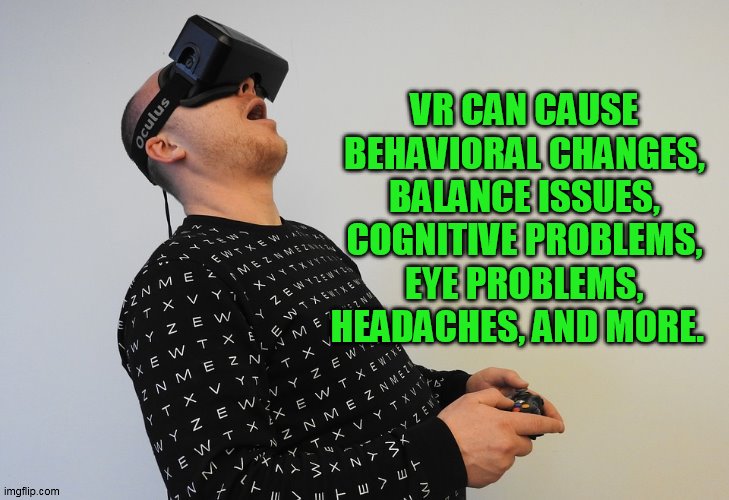 By B.N. Frank
By B.N. Frank
Research has proven that using VR headsets can cause behavioral changes, balance issues, cognitive problems, eye problems (soreness, vision changes), headaches, and MORE. In fact, last month, Facebook recalled millions of VR face liners due to users reporting rashes and hives!
Despite all of this, tech companies continue to create, promote and sell VR products for educational, employment, medical, and recreational purposes (see 1, 2, 3, 4). Facebook is one of them and its Horizon Workrooms technology is already getting bad reviews.
From Quartz:
Facebook Workrooms brings the worst of in-person office life to virtual reality
At this point in the pandemic, I would happily sit through a meeting that could have been an email if it meant being in the same room with a bunch of work friends. So when Facebook released Horizon Workrooms, an app that allows people to gather in a virtual-reality office, I was prepared to keep an open mind about its potential.
After all, humanity seems destined to one day leap into the metaverse, the internet we will not just use but inhabit, so why not check out a vision of what that might look like according to a powerful company that hopes to help shape it, for better or worse.
Only two other people at my office own, or will admit to owning, an Oculus Quest 2 headset, the $300 headset required to experience Workrooms in VR. Together we created a tiny focus group: This would be the first time we’d try to connect with others’ avatars in a virtual workspace.
The first Workrooms challenge: Finding your way into a virtual meeting
Fortunately for Facebook, people’s lasting impressions of experiences are heavily influenced by how they end and not how they begin. Unfortunately for us, our onboarding process was bumpy.
As the only Gen-Xer in the group, I worried I might live up to stereotypes about older employees being stumped by new technology, so I was mortified when I could not find my way into the first meeting room I was invited to join. Instead, I landed on the virtual screen that acts as a portal for non-virtual guests to attend any gathering, as if on a regular video call.
Looking through my headset, I could see my cartoon avatar waiting to be teleported. On my laptop screen, the avatar for Quartz’s CEO, a willing participant in our little experiment, sat alone. When I created a meeting room and invited him, we found ourselves in the same predicament, but with our roles reversed. (For the record, it’s surreal and somewhat embarrassing to be a dorky avatar staring up at the image of a real person on a video call-in screen. I understand why this feature has to exist when headsets are not yet in everyone’s tech arsenal, but I doubt that avatar-video hybrid meetings will be a hit.)
By our second attempt, I figured out what had gone wrong: Although it would seem intuitive to use your company email account to sign up for a workplace product, you actually need to log in with the same address you use for Facebook. This had not been obvious to me, nor to a third member of our group who also first appeared on the video screen in her headset. The takeaway: If you’re going to try Workrooms, be prepared to share your ancient hotmail address, or maybe a nickname that hasn’t been a part of your life since college, with your present-day peers and manager.
The second Workrooms challenge: “What are my arms doing now?”
Eventually, all three of us came together in the app’s conference room, where we initially spent some time checking out our digital bodies. The Oculus had warned us that “legs may not be possible” in every app, so it wasn’t exactly surprising to find our bodies disappeared into floating blue office chairs at about hip level, but it was distracting.
It turns out that this isn’t merely a result of Facebook rushing out a product a bit early in VR, replicating legs that can walk or run is complicated, so they are absent in other VR meeting apps, too, including within the more graphically rich Spatial app, and in MeetinVR.
You might imagine then that one’s virtual arms would compensate for the missing bottom limbs, but in Workrooms, they were instead unwieldy at times, often busy with their own projects underneath our virtual conference room table, or hanging in mid-air.
The app insists that users turn on hand tracking so your plastic controllers can be used as whiteboard pens, but the hand and finger functions seem glitchy and frustrating. To pick something up or select from menu items, you’re supposed to make a pinching motion with your real fingers, which takes practice. At times we appeared to lose our CEO’s attention as his avatar stared at his hands grabbing the air, seemingly catching flies Karate Kid-style…
Metaverse? Meh-taverse…
Got kids? Research has determined that children absorb 2-5 times more harmful radiation than adults while wearing VR headsets. Is that what you want for your children?!
Activist Post reports regularly about Virtual Reality (VR) and other unsafe technology. For more information, visit our archives and the following websites:
- Electromagnetic Radiation Safety
- Environmental Health Trust
- Physicians for Safe Technology
- Wireless Information Network
Become a Patron!
Or support us at SubscribeStar
Donate cryptocurrency HERE
Subscribe to Activist Post for truth, peace, and freedom news. Follow us on Telegram, SoMee, HIVE, Flote, Minds, MeWe, Twitter, Gab, Ruqqus, and What Really Happened.
Provide, Protect and Profit from what’s coming! Get a free issue of Counter Markets today.

Be the first to comment on "Facebook’s VR Workrooms Experience Includes Heavy and Hot Headsets, Dull Rooms, Floating Avatar Bodies, Other Distractions"